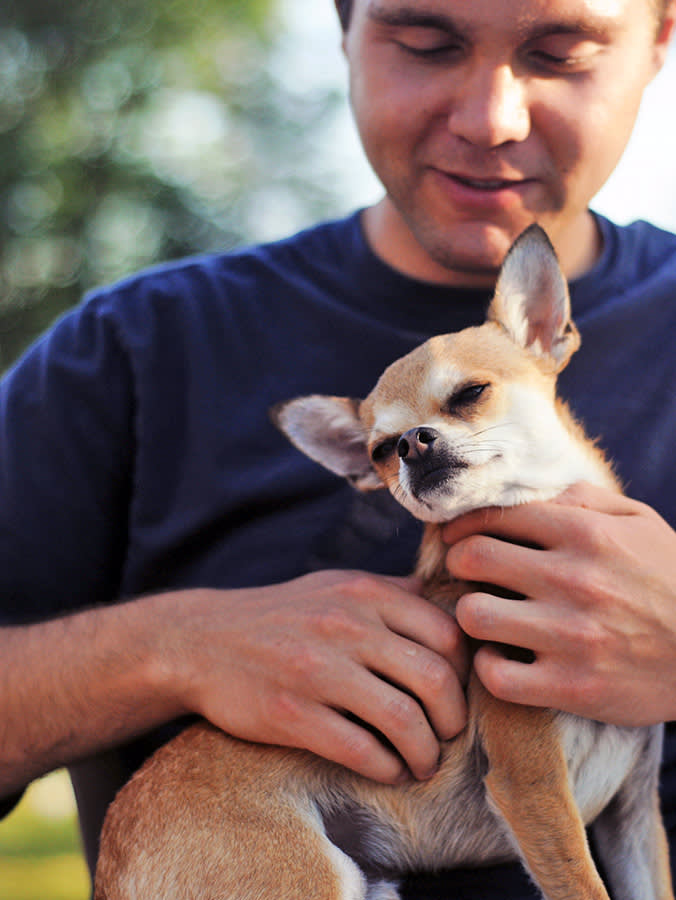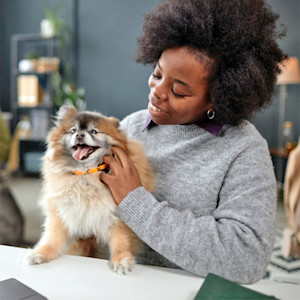10 Dog Breeds with the Longest Lifespans
Because we all wish our pets could live forever.

Share Article
The saddest part about having a pet in your life is knowing that their life on this earth is finiteopens in a new tab — and truly, all too short, no matter how long you get to spend with them. So, it makes sense that when you’re starting to do some research on dog breedsopens in a new tab (or mixes of those breeds) that you would zero in on those with the most longevityopens in a new tab.
Some dogs only live for around seven years, while other breeds can live as many as 18. If you are trying to minimize the heartbreak that comes from a pet crossing over the rainbow bridgeopens in a new tab, then maybe you do look at dog breeds with those longer lifespans. Although we have put together a list of breeds that live the longest below, keep in mind that this is, unfortunately, not a guarantee.

Get (totally free) deals for food, treats, accessories, tech, and way more pet parenting must-haves.
opens in a new tabAs much as any devoted dog parent doesn’t want to admit it, unexpected illnesses or challenges arise that could make the end come sooner than you want. But that’s not what we are focused on. Right now, let’s look at the positive, hope-giving stats you came here for.
The longest-living dog breeds
We found 10 breeds that, on average, have the longest lifespans for dogs. Most of the breeds below are small- or medium-sized dogs. Scientists are still doing research as to why this is, but some of it is attributed to the bodies of larger dogs aging faster than the bodies of smaller dogs, according to the American Kennel Clubopens in a new tab (AKC).
We talked to Dr. Beth Turner, who has been a veterinarian for 20 years and currently works for Preventative Vetopens in a new tab, an organization dedicated to educating pet parents.
“In my professional experience, most dog breeds can live longer when pet owners take the extra steps to keep their dogs physically and mentally healthy,” she says. “Typically, small-breed dogs, especially mixed, tend to live longer. But I have seen, when preventative care is used by pet owners, large- and giant-breed dogs live to be considered geriatric.”
As always, we recommend rescuing a dog, especially as countless pups need homesopens in a new tab. And remember, if you do have your sights set on a certain breed, chances are you will find it at a rescue or shelteropens in a new tab.
Cavalier King Charles Spaniel
Cavaliers, the preferred companion of kings and queens, are happy to spend their lives cuddling up to every human available. These needy pups can live up to 14 years oldopens in a new tab and will spend all of those years following you around the house (I can attest from the personal experience of growing up with three of these dogs). Cavaliers are prone to heart disease, hip dysplasiaopens in a new tab, and eye issuesopens in a new tab, so it’s imperative that they go to the vet regularly for check-ups.
Pomeranian
Poms might look like an animated cotton ball, but they’ve got several dogs’ worth of personality and sass — and they’ll let you know exactly what they think their entire lives. They also believe they’re a lot bigger than they are, so don’t be surprised when your Pomeranian becomes the family guard dog. These small pups can reach age 16opens in a new tab, but they suffer from little-dog health problems, like collapsing tracheaopens in a new tab, dental issues, and luxating patellas.
Australian Cattle Dog
As far as medium-sized dogs go, the Australian Cattle Dog has the longest lifespan on this list. Living 12 to 16 yearsopens in a new tab, this highly active pup is happiest when they have a job to do (even if that job is to play or herd the people in your household). These canines do best in active homes, and it’s even suggested that they participate in dog sports. This breed can develop hip dysplasia and progressive retinal atrophy as they get older.
Toy Poodle
The smallest of the Poodle breed, Toy Poodles can live up toopens in a new tab 18 years old. In our opinion, that means your Poodle should legally be allowed to vote. Not only because of their age — Poodles are very intelligent and easily master basic dog tricks. They need a lot of mental stimulation and exercise to keep them content, or they may become destructive. Like other small dogs on this list, Poodles can develop eye and dental issues.
Dachshund
This low-riding pup, affectionately called a wiener dogopens in a new tab, was named the sixth most popular dog breed in 2024opens in a new tab by American Kennel Club. These pups can live up to age 16opens in a new tab (with the oldest one on record reportedly making it opens in a new tabuntil age 25), though they are susceptible to spine issues, like intervertebral disc disease. Despite their spine issues, these dogs are high-energy, because they used to be pest hunters. To prevent this, Dachshund parents should be very careful when picking up their dogs and monitor how much they jump around.
Yorkshire Terrier
Yorkies are surprisingly brave and curious for a dog that easily fits inside of most purses. They typically live for 11 to 15 yearsopens in a new tab and are considered relatively hardy, though they can develop patellar luxation, tracheal collapse, and liver shunts. Yorkies have a thinner coat of fur that doesn’t require much grooming, but they may need a collection of coats opens in a new taband sweaters for the winter, because their body doesn’t tolerate cold well. With their history as mousers, these little pups do need exercise and mental stimulation to keep them happy.
Maltese
Malteses, part of the little white, yappy-dog group, can reach up toopens in a new tab 15 years of age. Perhaps their spirited vocalizations add years onto their lives. These little companions are generally considered a healthy breed, though they can have heart defects. Pet parents will also have to keep up on their dental care, because small dogs often develop teeth issuesopens in a new tab. Malteses prefer to be around people at all times, so if they’re left alone too long, they can grow stressed and develop separation anxietyopens in a new tab. It’s best if their pet parents are also homebodies.
Shiba Inu
This strong-willed, medium-sized pup can liveopens in a new tab from 13 to 16 years old. Known for their foxy faces, curly tails, and high-pitched, scream-like barks, Shiba Inus don’t face many health issues, aside from allergiesopens in a new tab. But if you’re a first-time dog parent, be aware that these dogs need a lot of attention and dedicated training. They’re a very active breed with a lot of opinions (which they aren’t afraid to share).
Shih Tzu
Shih Tzus, with their ponytail-style locks, can live anywhere from 10 to 18 years, commonly reachingopens in a new tab up to 13 to 14 years old. These gentle, sweet pups are meant to be lap dogs, though they still require playtime. Shih Tzus are a brachycephalic breedopens in a new tab, which means they have a smushed face (similar to a Pug’s), so they could develop problems breathing or overheat easily.
Chihuahua
This pint-sized pup might look a little fragile and anxious, but they are surprisingly sturdy. They live an averageopens in a new tab of 15 years, with some living as many as 20 years. That said, they are prone to heart diseaseopens in a new tab, and many small dogs can develop spinal issues. If you’re considering a Chihuahua as a pet, you should keep in mind that they need regular exercise and mental stimulationopens in a new tab to keep them healthy and happy.
The importance of preventative care
Dr. Turner stresses that preventative care is essential to keeping dogs as healthy and happy for as long as possible.
“Obviously, not all medical issues can be prevented,” Dr. Turner says. “But there are preventative and proactive measures pet owners can take to address medical conditions in order to delay their development and slow their progression. For example, feeding a dog a high-quality, well-balanced diet opens in a new tabat the proper amount — as well as keeping the dog active — helps prevent obesity and slows the development of arthritis. Routine blood work on dogs allows for the early detection of medical issues when they are most treatable and less costly to address.”
She also mentions that working with your pet’s veterinarian to not only prevent but lessen the severity of certain ailments is crucial in protecting your pet’s happiness and comfort.
Lifespan vs. lifestyle
While it’s tempting to choose a dog based on their longetivty, it’s not always that simple. When considering whether you want to get a dog breed, Dr. Turner recommends not taking lifespan too heavily into account. There are other factors you should focus on (besides how much you’re going to love your new pup!).
“Rather, they should research what medical issues that breed is predisposed to as well as the type of lifestyle that breed needs to thrive,” she says. “Understanding a breed’s lifestyle may sound strange, but when a dog cannot behave in a way that is ‘natural or instinctual’ to them, it can cause stress and anxiety, which can lead to medical issues that could shorten their life.”

Alicia Kort
Alicia Kort is a writer and editor living in Brooklyn. She’s currently the senior commerce editor at Apartment Therapy. She’s been published in StyleCaster, Electric Literature, Newsweek, Interview, Brooklyn magazine and more. In her free time, she runs, reads, and spends time with her dog-nieces, Maya and Lady, and her cat-niece, Pepper.
Related articles
![Hands of an unrecognizable woman are petting small Dachshund dog in the park.]() opens in a new tab
opens in a new tabSmall Dogs With Long Noses Live the Longest, New Study Finds
Scientists are seeing some trends when it comes to pup mortality.
![Young caucasian cheerful blonde girl sitting and hugging her lovely cocker spaniel dog in cafe.]() opens in a new tab
opens in a new tab10 Longevity Tips From People Whose Pets Have Lived Incredibly Long Lives
Follow these vet-backed tips to help your best bud live a healthy and full life.
![senior dog]() opens in a new tab
opens in a new tabA New Drug Could Make Your Dog Live Longer—Meet the Woman Who Created It
The founder and CEO of Loyal, Celine Halioua, tells Kinship what the future of pet parenthood could look like, starting with more time with your pup.
![Woman petting her senior Pomeranian dog.]() opens in a new tab
opens in a new tab11 Natural Products That Can Help Your Dog Live Longer
Integrative veterinarian Dr. Lindsey Wendt’s recs for products that can help your pet sail into their golden years in good health.
![Young Woman With Two Brown Dogs.]()
Research Finds Dogs With More Human and Animal Buddies Live Longer
A new study suggests that spending time with your pup isn’t just a way to avoid making plans; it’s great for their health.














